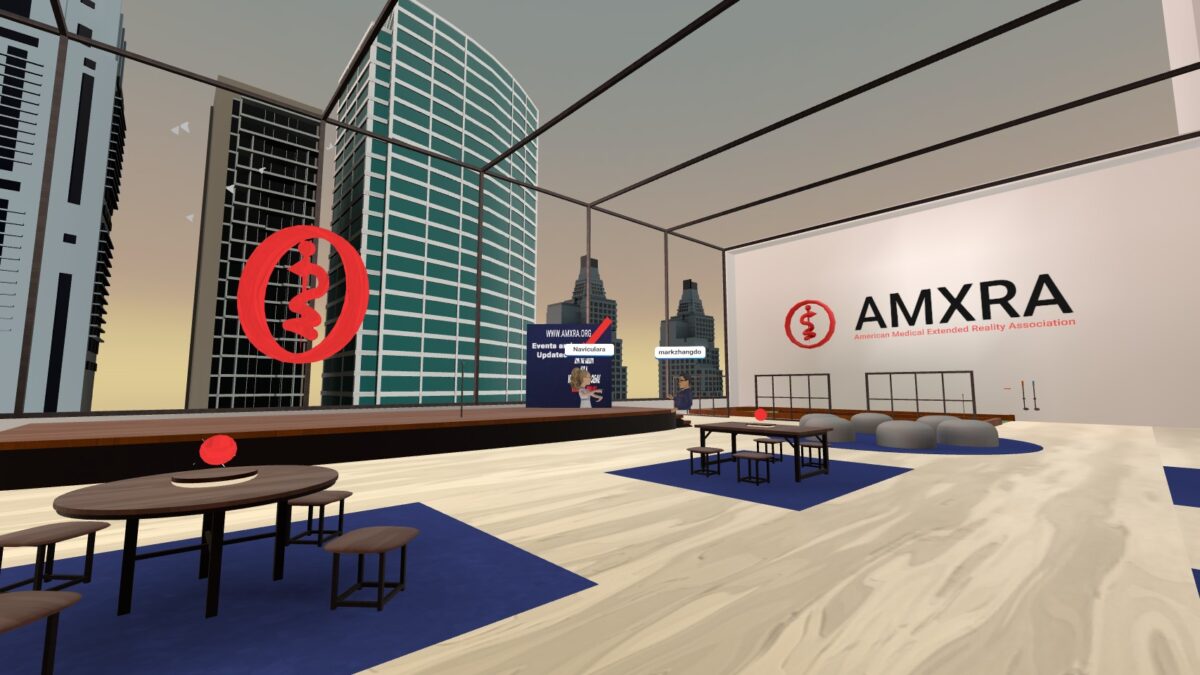The healthcare industry has been an early adopter of extended reality, or XR — the umbrella term for immersive technologies, including virtual reality, augmented reality and mixed reality. While some tech observers are ready to declare XR, especially the “metaverse,” dead in the water, medical professionals are increasingly seeing its value, so much so that there is a term for the intersection of XR and medicine: MXR.
Therapies to comfort patients with calming immersive surroundings are the tip of the iceberg.
In 2022, Dr. Mark Zhang, associate chief medical information officer at Brigham and Women’s Hospital in Boston, saw the need for medical professionals to connect over these emerging technologies, and founded the American Medical Extended Reality Association, aka AMXRA.
While Dr. Zhang’s niche has long been digital health and innovation, AMXRA wasn’t born because of MXR is ubiquitous — at least, not yet. Instead, the organization came to life because MXR’s prevalence, and healthcare providers use of the tech, wasn’t widely understood.
At the Boston hospital, Zhang runs a team called the Innovation Hub. He told Technical.ly this during an interview held in AMXRA’s virtual HQ in Horizon Worlds (which also happens to be the redesigned space that formerly housed Worlds’ first healthcare hub, HouseCall VR, before it moved to a new space).
AMXRA is a nonprofit, interprofessional, interdisciplinary medical society focused on advancing the science and practice of medical extended reality.
“We do application creation and help move ideas forward,” Zhang said of this team. “About a year and a half ago, we were asked by our leadership to start more explicitly exploring emerging technologies and come up with a system to address them. It was in that context that we started looking at VR, mainly because no one on the team had any sense of what was going on in MXR healthcare.”
What they found was more than 30 MXR projects and millions of dollars of research already happening by independent, totally unconnected teams that often knew nothing about each other.
They realized those groups needed a community to connect and share what they were doing with peers, and that work needed to be treated as seriously as any other medical field. They needed a medical association. So Zhang created one.
AMXRA, still less than six months old, is a nonprofit, interprofessional, interdisciplinary medical society focused on advancing the science and practice of medical extended reality. Earlier this month, the org made its debut at the the International Virtual Reality Healthcare Association (IVRHA) Global Symposium in Philadelphia, where it picked up a couple dozen new members.
With emerging technologies evolving so quickly in 2023, especially artificial intelligence and immersive tech, the timing seems right to Zhang. He sees four areas of value in MXR:
1. Clinical applications such as distraction therapy, group therapy for mental health, or optical interventions to treat conditions like lazy eye
Before VR headsets were widely accessible in 2018, Delaware healthcare system ChristianaCare won a Magnet Award from the American Nurses Credentialing Center for using virtual reality to improve patients’ experience during chemotherapy. That application, called distraction therapy, is used now as part of treatment for different kinds of patients, including children.
2. Education such as medical training modules or simulations of scenarios
HouseCall VR, founded by Delaware podiatrist Dr. Linda Ciavarelli, is a leading immersive hub for sharing information in VR. As noted above, the world has undergone a recent redesign, which launched with the in-world event “Diabetes from the Inside Out” featuring Dr. Michael Dansinger and a walk-through VR model of the pancreas. Word was spread through its Facebook page, where people without headsets could also participate via Facebook Live, and it drew a crowd that was a combination of medical professionals and everyday users interested in learning.
The tour through the virtual model was educational for adults, though like some of HouseCall VR’s other exhibits, it also shows how valuable VR can be in educating K-12 students. Most schools can only afford one trip to a science museum per year, if that; VR will make it possible to supplement real-life trips with a potentially endless supply of interactive dives.
“People came up to me after and said, you know, I want to take better care of my pancreas now, and I didn’t even know I had one!” Ciavarelli said.
3. Productivity tools such as event hosting
Janette Arencibia, operational medical tech titan for the US Marines Reserves and liaison for AMXRA, uses AMXRA’s meeting space in Worlds, which includes a stage, seats and a small mini golf area. She recently used the space as the site of the first global health engagement between the US and Colombia for what’s called a subject matter expert exchange.
“This [technology] has the potential to change how humans interact with one another, because I no longer have to get a passport or visa,” said Arencibia, who joined Technical.ly in the AMXRA HQ during its weekly open house. “I no longer have to potentially travel to talk to somebody around the world. I can collaborate in this space. It’s a great opportunity.”
There are limits on what you can do with the space; Zhang noted that the lack of whiteboard or screen share-type feature for presentations like what you’ll find in Zoom makes some potential meetings challenging. But it’s a feature that is expected to come before long.
Worlds’ simplicity at this point is a common complaint, but Zhang is quick to remind that the metaverse is still in its infancy: “It’s basically Geocities,” he said, referring to the early-internet website host that allowed the average person to create sites that now look impossibly primitive.
4. Creative XR use cases
“I hear one or two things every couple of months where I’m like, wow, I never would have thought of using XR to do X, Y, Z,” Zhang said, “and those are the things that I think are so fascinating.”
Zhang mentioned Bodyswaps, a Barcelona-based company that exhibited at IVRHA, as an example of one such use case. The VR training program allows users to see themselves through others’ eyes as they swap avatars. For example, it can be used in a mock job interview, where you both answer the questions and see yourself answering them so you can rate yourself and improve. It can be used to build collaboration and communication skills, and even empathy, with a series of “judgement-free” workshops where users explore bias and privilege.
“It’s an empathy machine,” Ciavarelli said.
###
AMXRA holds open houses on Tuesdays from 7 to 8 p.m. EST (Worlds name: AMXRA), where you can check out the space and learn more about the association.
Watch a clip of Dr. Zhang talking about MXR in VR here:
Join the conversation!
Find news, events, jobs and people who share your interests on Technical.ly's open community Slack

Delaware daily roundup: Delmarva Power vendor stats; DelDOT's $15M federal grant; 50 best companies to work for

Delaware daily roundup: Over 4,000 Black-owned businesses uncovered; Dover makes rising cities list; a push for online sports betting

Philly daily roundup: East Market coworking; Temple's $2.5M engineering donation; WITS spring summit


